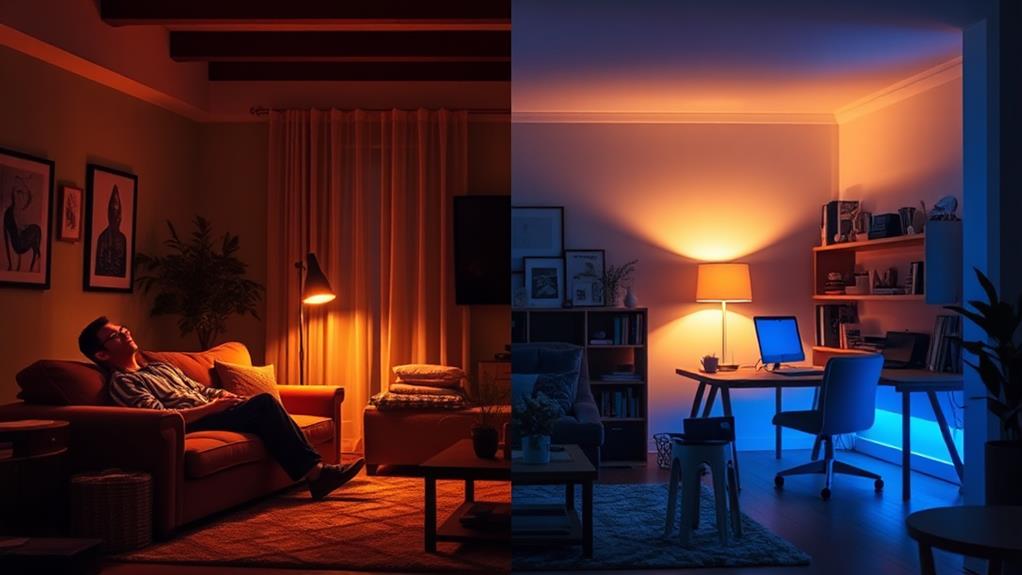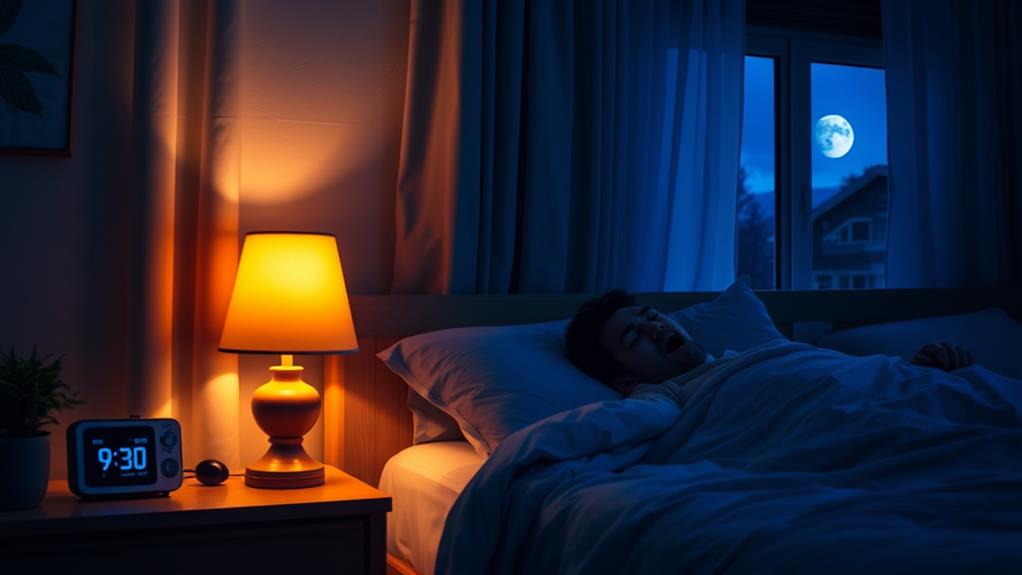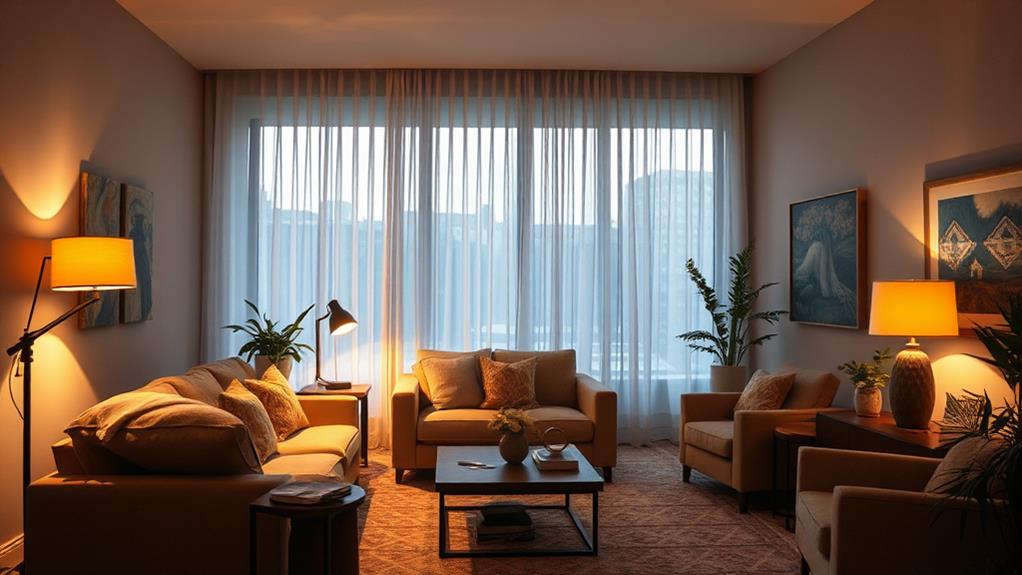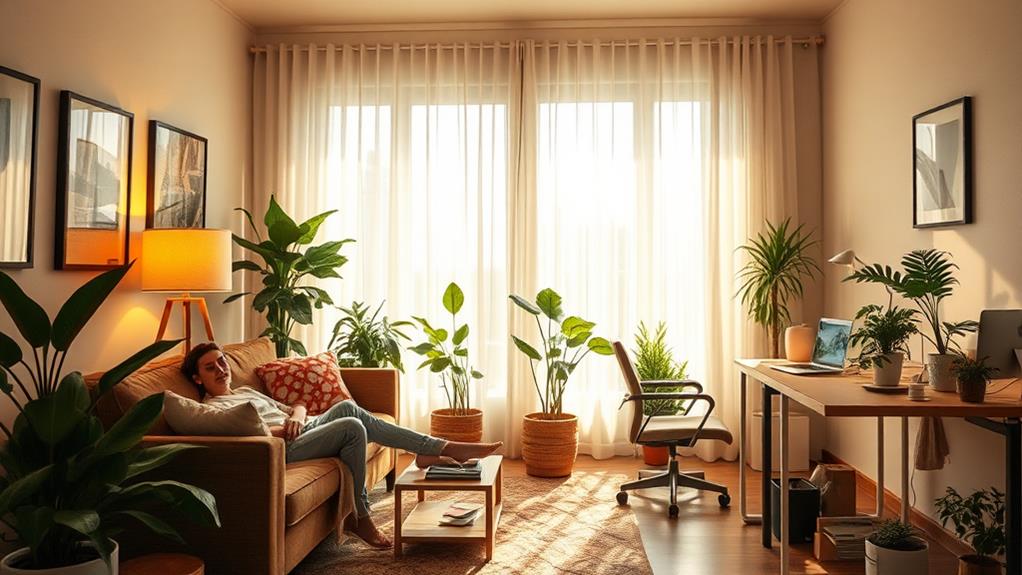Lighting in your home profoundly affects your mood and productivity. The type, intensity, and color of light can influence your circadian rhythms, hormone production, and overall well-being. Natural light boosts mood and cognitive function, while artificial lighting offers control and consistency. Warmer color temperatures create a cozy atmosphere, ideal for relaxation, while cooler tones mimic daylight and enhance alertness. Proper task lighting reduces eye strain and improves focus, while ambient lighting promotes relaxation. By strategically incorporating both natural and artificial light sources, you can optimize your home environment for better sleep, increased productivity, and improved mood. Discover how to harness the power of light to transform your living space.
The Science of Light

Light invariably influences our daily lives in ways we often overlook. The science behind this phenomenon reveals that light affects our circadian rhythms, hormone production, and overall well-being. When light enters your eyes, it stimulates photoreceptors in your retina, which then send signals to your brain's hypothalamus. This process regulates your body's internal clock, influencing sleep patterns, mood, and energy levels.
Different types of light have varying effects on your body and mind. Natural sunlight contains a full spectrum of colors, including blue light, which helps boost alertness and cognitive function during the day. However, exposure to blue light from artificial sources like screens can disrupt your sleep cycle if experienced in the evening.
Warm, yellow-toned light mimics the setting sun and promotes relaxation, making it ideal for winding down before bed. Cool, white light, on the other hand, can increase productivity and focus, making it suitable for workspaces. By understanding these principles, you can strategically use lighting in your home to optimize your mood, energy levels, and overall productivity throughout the day.
Natural vs. Artificial Lighting
While both natural and artificial lighting play crucial roles in our lives, they differ significantly in their impact on our well-being and productivity. Natural light, which comes from the sun, provides a full spectrum of colors and changes throughout the day, mimicking our circadian rhythms. It's known to boost mood, increase vitamin D production, and improve sleep quality.
On the other hand, artificial lighting offers consistency and control. You can adjust its intensity and color temperature to suit your needs. However, it often lacks the full spectrum of natural light and can disrupt your body's natural rhythms if used improperly.
To maximize the benefits of both, try to incorporate as much natural light as possible into your home. Position your workspace near windows and use sheer curtains to filter harsh sunlight. When natural light isn't available, opt for artificial lighting that mimics daylight. Use warm, dim lights in the evening to signal your body it's time to wind down. By strategically combining natural and artificial lighting, you'll create a more comfortable, productive, and healthy home environment that supports your well-being throughout the day.
Color Temperature and Mood

In accordance with scientific research, color temperature plays a crucial role in shaping our mood and productivity. You'll find that warmer color temperatures, typically ranging from 2700K to 3000K, create a cozy and relaxing atmosphere. These yellowish hues are ideal for living rooms, bedrooms, and spaces where you want to unwind. They can help reduce stress and promote better sleep, making them perfect for evening use.
On the other hand, cooler color temperatures between 4000K and 6500K mimic natural daylight and can boost your alertness and focus. You'll want to use these bluish-white lights in areas where you need to concentrate, such as home offices or study spaces. They're particularly effective during the day when you need to maintain productivity.
Light Intensity and Focus
Intensity plays a crucial role in how lighting affects your focus and productivity. When you're working or studying at home, the right light level can significantly enhance your concentration and efficiency.
Bright light, typically around 1,000 lux, can increase alertness and improve cognitive performance. This is especially beneficial for tasks requiring high attention to detail or prolonged focus.
However, it's important to note that excessively bright light can cause glare and eye strain, potentially leading to headaches and decreased productivity. On the other hand, dim lighting may induce drowsiness and reduce your ability to stay focused. To find the optimal intensity, consider using adjustable lighting fixtures or smart bulbs that allow you to customize the brightness based on your current activity.
For general work tasks, aim for light levels between 300 to 500 lux. When reading or doing detailed work, increase the intensity to 500 to 800 lux. Remember to balance artificial light with natural daylight when possible, as it provides a full spectrum of light that can positively impact your mood and circadian rhythm. Experiment with different intensities throughout the day to find what works best for your specific needs and tasks.
Circadian Rhythms and Sleep

Light's impact on productivity extends beyond focus and into the realm of your body's natural rhythms. Your circadian rhythm, the internal clock that regulates sleep-wake cycles, is heavily influenced by light exposure. By understanding and harnessing this connection, you can optimize your home lighting to improve sleep quality and overall well-being.
Natural daylight plays a crucial role in regulating your circadian rhythm. Exposure to bright light during the day, especially in the morning, helps suppress melatonin production and increases alertness. To maximize these benefits, position your workspace near windows and use cool, bright lights during daytime hours.
As evening approaches, your body naturally begins to produce melatonin, preparing for sleep. Artificial lighting can disrupt this process. To support your circadian rhythm, gradually dim lights and shift to warmer color temperatures in the evening. Consider using smart bulbs or automated lighting systems to create a sunset-like effect in your home. Avoid exposure to blue light from screens at least two hours before bedtime, as it can interfere with melatonin production. By aligning your home lighting with your body's natural rhythms, you'll improve sleep quality and boost daytime productivity.
Task Lighting for Productivity
Task lighting's role in enhancing productivity can't be overstated. When you're working on specific tasks, proper illumination is crucial for maintaining focus and reducing eye strain. To optimize your workspace, consider using adjustable desk lamps or under-cabinet lights that allow you to direct light precisely where it's needed.
For reading or detailed work, opt for cool white LED bulbs with a color temperature of 4000K to 5000K. These mimic daylight and help keep you alert. Position your task light to minimize glare on screens and avoid casting shadows on your work surface.
Don't forget about the importance of contrast. Ensure your task lighting is brighter than the ambient light in the room to reduce eye fatigue. However, avoid extreme differences that can cause discomfort.
For computer work, consider using bias lighting behind your monitor. This reduces eye strain and enhances perceived screen contrast. Remember to adjust your task lighting throughout the day as natural light changes. By tailoring your lighting to specific tasks, you'll create an environment that boosts productivity and supports your well-being.
Ambient Lighting for Relaxation

After a long day of focused work, it's essential to create an environment conducive to unwinding. Ambient lighting plays a crucial role in setting the mood for relaxation. You'll want to choose soft, warm light sources that mimic the soothing glow of sunset. Opt for dimmable fixtures or smart bulbs that allow you to adjust the intensity and color temperature.
Consider using floor lamps, table lamps, or wall sconces to create a layered lighting effect. These sources diffuse light evenly, eliminating harsh shadows and promoting a calm atmosphere. Salt lamps and Himalayan salt night lights are popular choices for their warm, orange hue and alleged air-purifying properties.
Don't overlook the power of natural light. In the evening, gradually transition from bright overhead lights to softer options as the sun sets. This helps signal to your body that it's time to wind down. You can also use light therapy devices to regulate your circadian rhythm, especially during darker winter months.
Smart Lighting Solutions
Smart lighting solutions have revolutionized the way we interact with our home environments. These systems offer unprecedented control over your lighting, allowing you to adjust brightness, color, and timing with ease. You can create custom scenes for different activities, moods, or times of day, enhancing both comfort and productivity.
With smart bulbs and fixtures, you'll have the power to control your lights remotely via smartphone apps or voice commands. This means you can turn lights on or off, dim them, or change their color from anywhere in your home or even when you're away. Many smart lighting systems also integrate with other smart home devices, enabling you to create automated routines that adjust your lighting based on factors like time, occupancy, or external conditions.
Some advanced smart lighting solutions incorporate circadian rhythm features, automatically adjusting color temperature throughout the day to support your natural sleep-wake cycle. This can help improve your sleep quality and daytime alertness. Additionally, energy-efficient LED smart bulbs can significantly reduce your electricity consumption, leading to lower energy bills and a smaller carbon footprint.
Lighting Design Best Practices

Lighting design principles can transform your living space from ordinary to extraordinary. To achieve optimal lighting, you'll want to incorporate layers of light.
Start with ambient lighting as your base, using ceiling fixtures or recessed lights to provide overall illumination. Next, add task lighting for specific activities like reading or cooking. This can include desk lamps, under-cabinet lights, or pendant lights over a kitchen island.
Don't forget accent lighting to highlight artwork, architectural features, or create focal points. Use wall sconces, track lighting, or picture lights for this purpose. Consider the color temperature of your bulbs; warm light (2700-3000K) creates a cozy atmosphere, while cool light (3500-4100K) is better for task-oriented spaces.
Dimmers are essential for adjusting light levels throughout the day and for different activities. Position lights to minimize glare and shadows, especially in work areas. Use light-colored walls and reflective surfaces to bounce light around the room, making it feel brighter and more spacious. Finally, don't underestimate the power of natural light – maximize it with sheer curtains or strategically placed mirrors.
Conclusion
You're the captain of your home's ship, navigating the seas of mood and productivity. Your lighting is the compass guiding you through calm waters and stormy nights. With the right illumination, you'll chart a course for success, steering clear of fatigue's rocky shores. Don't let poor lighting leave you adrift—adjust your sails with smart solutions and best practices. Remember, a well-lit journey leads to brighter horizons and smoother sailing in your daily life.

